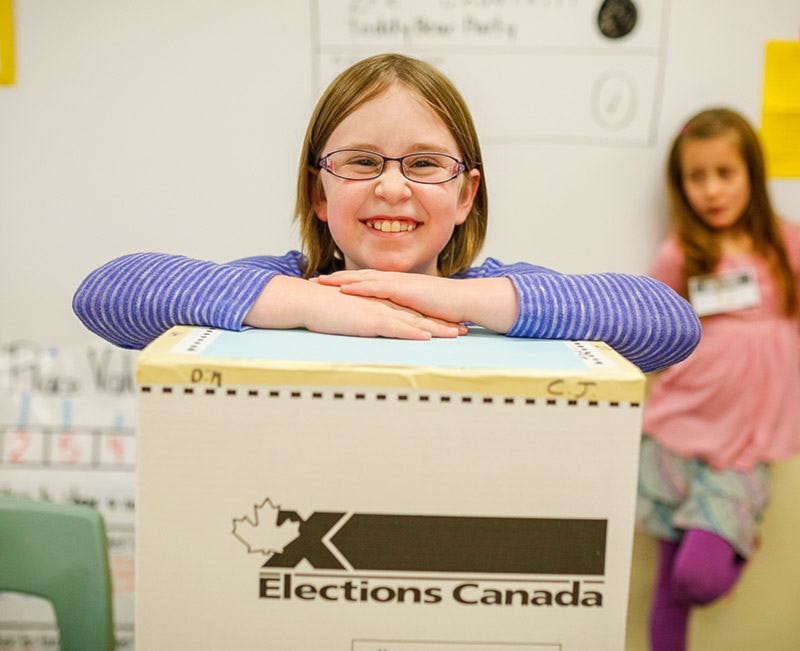Yukon students came close to predicting the outcome of the territorial election with a mock vote in schools across the territory on Monday.
Students from 19 elementary and high schools, representing 13 of the territory’s 19 ridings, cast a total of 1,371 ballots at school as their parents were going to the polls on Monday. They elected a Liberal minority government with seven seats and an NDP Opposition with four seats, leaving the Yukon Party in third place with just two seats.
The exercise, organized by the national organization CIVIX, was an attempt to teach young Yukoners about the importance and process of voting.
Though they accurately predicted a Liberal government, the students picked only four of the candidates who were actually elected — the NDP’s Kate White and Liberals Nils Clarke, Tracy McPhee and Paolo Gallina. Because the Robert Service School in Dawson City didn’t participate, Liberal Leader Sandy Silver wasn’t voted in.
The students stuck with a number of incumbents who were actually voted out, including the NDP’s Lois Moorcroft and Jim Tredger and the Yukon Party’s Mike Nixon and Darius Elias.
They also chose Liberals Mathieya Alatini, Alan Young and Carl Sidney and the NDP’s Erin Labonte in rural ridings, though all four were defeated by the Yukon Party in the actual election.
And apparently undeterred by the RCMP investigation into the handling of proxy ballots in Whitehorse Centre, the students elected Liberal Tamara Goeppel over NDP Leader Liz Hanson.
CIVIX founder Taylor Gunn said student elections typically do predict actual election results. That could be because students vote the way their parents do. But Gunn said the reverse could also be true.
“Now what we hear from some teachers is that parents will come in and admit that the kids changed their decision of who to vote for, because they felt that their kids knew more than them,” he said.
Notably, Yukon students were much more likely to vote Green than their parents. The Yukon Greens won six per cent of the student vote, compared to just 0.8 per cent of real ballots.
One of those young Green supporters is nine-year-old Lilly Salvin, a Grade 4 student at Jack Hulland Elementary School in Porter Creek.
“The Green Party will make the world a better place by making it so cars don’t run on gasoline so it won’t affect the air and so you won’t litter as much as you do,” she said. “Because almost in like a few years, there’s a lot of animals that are almost extinct. So people might not be able to know about them in the future.”
Unfortunately, Lilly couldn’t actually vote Green on Monday, because there was no Green candidate in Porter Creek South.
But she still got a first-hand look at how voting works. Her teacher, Valerie Ireland, set up a mock polling station for the Grade 4 class and two Grade 5 classes, complete with voter registration forms, ballots and voting booths.
Lilly acted as a poll clerk after she cast her own ballot. She said it was fun to learn about the process.
“So when we get older and we have to actually do the real vote, we know what to do,” she said.
Eight-year-old Darwin Murray acted as a returning officer. “It means that I make sure nobody’s putting in two votes, or doing anything wrong,” he explained.
He wasn’t so sure about which candidate he supported, but he said that “kids should know how to vote when they’re older.”
Ireland said her students started asking about the election when they saw lawn signs appearing in their neighbourhoods.
Over the last three weeks, she’s taught them about ridings and MLAs. They also watched videos sent in by the four party leaders in response to questions from students across the Yukon.
“The response from the kids was great. They were very excited about it,” Ireland said. “They really like the idea that they could do something that the adults were doing, just like the adults were doing it.”
Ireland said it’s important to try and get kids interested in voting early on.
“Research says that even in the last federal election, only four out of 10 young people participated in the vote,” she said. “I look at the kids in my class, and they’re going to be running the community one day.… I just think it’s really important for them to know about where they live.”
This is the 35th student election that CIVIX has organized across the country. Gunn said the organization doesn’t yet know if kids that participate in student votes are more likely to become voters.
But the mock votes do seem to be having an impact on parents. “Twenty-eight per cent of the parent respondents in the recent federal election said that their student participating in the student vote positively impacted their decision to vote,” he said.
And certainly, both Lilly and Darwin say they are planning to vote for real when they turn 18.
“Because if you don’t vote, you can’t complain about who’s elected,” Lilly said.
Contact Maura Forrest at maura.forrest@yukon-news.com
